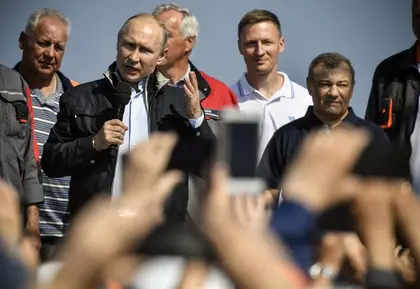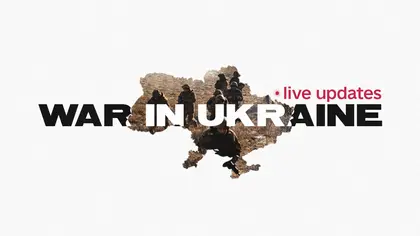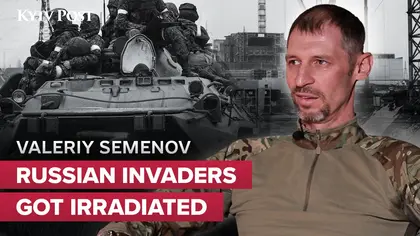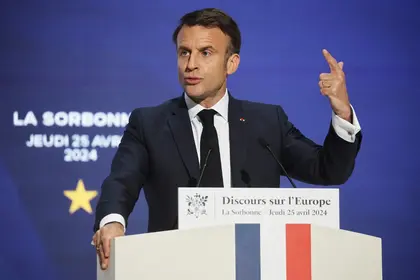Russia’s war against Ukraine, having already killed more than 10,000 on land over the past four years, may soon shift to the sea.
Experts say that Russian President Vladimir Putin’s opening of the Crimean Bridge on May 15 marked the Kremlin’s assumption of full control over the Kerch Strait. Now Russia is slowly expanding its military presence in the Azov and Black seas.
In the last few weeks of May, the Kremlin quietly redeployed six military vessels from its Caspian Fleet to the Azov Sea. They were shallow draught gunboats and coastal patrol boats designed for operations in shallow waters like those of the Azov Sea.
In May it also conducted the naval drills very close to the 12-nautical-mile zone of Ukraine’s territorial waters in the Azov Sea, closing part of the sea for its military exercises.
According to Paul Goble, an expert from the Jamestown Foundation think tank, this movement of forces is a show of force by Moscow to demonstrate that should Ukraine attempt to liberate any of the Russian-occupied Ukrainian territory on land, the Kremlin can counter with an attack from the sea.
Writing in the Eurasia Daily Monitor on May 31, Goble also said a “darker” interpretation of the redeployment of the warships is that Moscow may be considering a further attack on Ukraine, to establish a land corridor to link the Russian-occupied parts of the Donbas with Russian-occupied Crimea.
That would entail the Kremlin occupying still more of Donetsk Oblast, and at least parts of Zaporizhzhya and Kherson oblasts as well.
Meanwhile, the Kremlin has been causing Ukraine economic losses in the Azov Sea region. Since the end of May naval patrols of Russia’s Federal Security Service or FSB have been stopping international cargo vessels going to and from the Ukrainian ports of Mariupol and Berdyansk, searching crews and ships for hours, and causing thousands of dollars of losses to shipping companies and Ukrainian ports.
There are no Ukrainian Naval Forces ships constantly present in the Azov Sea, where Ukraine borders Russia, Boris Babin, the permanent representative of the president of Ukraine on Crimea issues, told the Kyiv Post on June 7.
Only the marine squads of the Ukrainian Border Guard Service patrol Ukraine’s territorial waters, but they can do nothing to stop Russia’s expansion. That’s because the Kremlin isn’t actually breaking any laws.
Incredibly, in the fifth year of Kremlin’s war in the Donbas and Crimea occupation, there are still agreements in place between Russia and Ukraine that practically erase Ukraine’s sea borders with Russia, allowing Russia to send its cargo and military vessels wherever it wants in the Azov Sea.
“Russia is not violating any laws, as formally the Azov Sea is our common national waters,” Oleh Slobodyan, the spokesman of the State Border Guard Service of Ukraine told the Kyiv Post on June 7.
Brotherly nations
In 2003 Ukrainian President Leonid Kuchma and Russian President Vladimir Putin signed an agreement between Ukraine and the Russian Federation on cooperation and the shared use of the Azov Sea and Kerch Strait. The agreement was ratified in 2004 and is still in force.
“Ukraine and the Russian Federation, two historically brotherly nations, define the Azov Sea and Kerch Strait as economically important for both countries,” the agreement reads.
The Azov Sea agreement also defines the sea as the common territorial waters of Ukraine and Russia, and reads that Ukraine and Russia are to decide where to draw their sea borders. The decision should have been made in 1997, but never was.
“Russia kept blocking all Ukrainian offers. We formally have our border ending on the coast of the Azov Sea,” Andrii Klymenko, the chief expert of the Maidan of Foreign Affairs NGO, which monitors all Russian and Ukrainian actions in Crimea and the Black Sea, told the Kyiv Post on June 6.
Ukrainian authorities and military forces have been doing all they can to strengthen Ukraine’s presence in the Azov Sea, but these actions remain secret, Babin said.
The government is planning to expand the border guard service squads to Henichesk, a small town in Kherson Oblast on the coast of Azov Sea, immediately to the north of Russian-occupied Crimea.
“But first we need to get 150,000 different approvals. It is ordinary Kyiv bureaucracy. It seems to me that some people in powerful positions don’t even remember that there’s war going on in Ukraine,” Babin said.
Economic blockade?
The Azov Sea is the shallowest sea in the world, only about 14 meters deep at most. Ukraine uses some of its deepest parts at the ports of Berdyansk and Mariupol, where depths are from eight to 10 meters. In Russian Azov Sea ports the depths are from three to seven meters. The Kerch Strait, where the Azov Sea meets the Black Sea, is at most some 17 meters deep.
While earlier Ukraine’s Mariupol and Berdyansk Ports were able to accept heavy cargo vessels (if they were lightly loaded), the Russians were forced to first load their cargos onto smaller vessels, which would pass through the Kerch Strait and then transfer their loads to bigger ships in the Black Sea.
After the Kremlin invaded Crimea in 2014 and started its occupation of the Ukrainian peninsula, Mariupol and Berdyansk ports started to accept part of the cargo traffic that formerly went to the Crimean ports. International sanctions forbade companies to do business with the ports in Russian-occupied Crimea.
However, after Russia started building the Crimean Bridge in April 2015, cargo transshipment in Mariupol Port in Donetsk Oblast dropped by more than 14 percent. It fell from more than 8.9 million tons of cargo in 2015 to 6.5 million tons in 2017, reads Mariupol port’s official website.
In Berdyansk Port in Zaporizhzhia Oblast the situation is even worse. According to its official website, cargo transshipment in Berdyansk dropped by more than 30 percent, from 4.5 million tons of cargo in 2015 to 2.4 million tons in 2017.
Klymenko said that in addition to the low height of the Crimean Bridge, which prevents large, heavy vessels from entering the Azov Sea at the Kerch Strait, Russia’s FSB has started stopping cargo vessels going to the ports of Mariupol and Berdyansk.
“It all started at the end of April. At first they said Ukrainian cargo vessels going to the Ukrainian ports were being stopped and searched due to the threat of terrorism. They said they were trying to catch Ukrainian saboteurs who were planning to blow up the bridge,” Klymenko said.
At first vessels were halted for a maximum of two hours. But in May the Russians started halting and searching vessels for longer periods. Vessels were halted “in accordance with the norms of Russian Federation law,” the FSB said.
Klymenko reported that since April FSB has stopped and searched more than 26 Ukrainian and international cargo vessels going from and to Ukrainian ports, without giving any clear reason.
“Vessels were forced to drop anchor for from eight to 10 hours. That’s already damaging the business, causing delays and therefore missing deadlines for cargo delivery,” Klymenko said.
Ayna Chagir, a Mariupol Port spokesperson, on June 6 confirmed to the Kyiv Post that vessels had been delayed, and said that some cargo vessels had been stopped and searched for more than 20 hours.
“This disturbing situation leads to increasing financial damages, as shipping companies have been losing from $5,000 to $15,000 a day because of these unreasonably long delays and stops,” Chagir said.
She added that due to the constant halting of vessels in the Kerch Strait and Azov Sea, Mariupol Port was empty from June 2 to June 4, and that also has caused financial losses to the port — one of the biggest contributors to Mariupol’s city budget.
“Shipping companies are businesses, and all this mess in the Azov Sea means risk,” Klymenko said.
“News spread quickly. Insurance companies are putting their prices up. Sailors don’t want to work on vessels that might be arrested by the unpredictable Russians.”
The expert added that more and more shipping companies are reorienting their cargo traffic to other, safer ports in the Black Sea region.
“To me this looks like the start of the economic blockade,” Klymenko said. “Ukraine should definitely respond somehow. State Border Guard Service boats must escort and protect cargo vessels going to and from Ukrainian ports.”
But Slobodyan said to do that, Ukraine needs better and more powerful military vessels than the armored motor boats of State Border Guard Service.
New battlefront
The confrontations at sea could also escalate from an economic blockade to a new active battlefront, experts say.
Russia explains its growing presence in the Azov Sea by the need to defend occupied Crimea and the newly erected bridge from Ukraine.
Russian-led forces in the Russian-occupied part of Ukraine’s Donetsk Oblast also claim they have their own Azov Sea fleet, based in the Russian-controlled village of Sedove in Donetsk Oblast, which is only about 50 kilometers east of Mariupol.
Goble of the Jamestown Foundation wrote that in 2016 Russian-led forces in Donetsk asked the Kremlin to send ships to the Azov Sea to supplement their own naval forces in order to seize more of the Ukrainian coast, but at that time the request was flatly turned down.
Something has apparently changed in the Kremlin’s calculus now, Goble added.
Indeed, when one of the Russian-led forces’ leaders, Zakhar Prilepin, told Putin during the president’s annual phone-in on June 7 that Ukraine might use the distraction on the 2018 World Cup in Russia to start a military offensive in the Donbas, Putin said: “If it happens, such a move will have serious consequences for Ukraine’s sovereignty.”
Babin said Ukrainian forces are fully prepared to protect Ukraine’s coast from possible attacks from the sea. But Ukraine still needs to strengthen its presence out into sea, and to expand its naval fleet.
Although Babin said that Ukrainian fleet is not present in the Azov Sea, the navy press service wrote on Facebook on June 7 that Ukrainian naval forces have been training in the Azov Sea since 2015, protecting the coast.
To push back against Russia’s expanding influence, Ukraine should proclaim its own economic zone in the Azov Sea, and define its territorial waters, Babin said.
Russia will object, Babin said, but Ukraine must do more to protect its borders on land and at sea. Since it started its occupation of Crimea, Russia has been expanding its presence not only in the Azov Sea but also in the Black Sea.
Soon after Russia began to occupy Ukraine’s Crimea, the Kremlin also seized the oil-derricks of the ChornomorskNeftegaz company, located in the Black Sea, closer to Ochakiv, Odesa Oblast.
In 2017, the Ukrainian Border Guard Service published pictures of armed men, wearing military uniforms, guarding the seized Ukrainian oil-derricks.
In the past, the Kremlin has avoided confirming it has a military presence near the oil derricks. However, in June the 41st Russian naval rocket vessel brigade officially started guarding the oil-derricks in the Black Sea, Russian newspaper Izvestia reported on June 5.
“As a citizen, I believe in the strength of the Ukrainian Army. But Ukraine must also protect its interests at sea,” Babin said.
Unfortunately, Ukrainians are only used to fighting on land, not at sea, Klymenko added.
Ukrainian President Petro Poroshenko said in 2016 that after Russia started its occupation of Crimea, Ukraine lost 70 percent of its navy, with only four warships and several dozen motor boats being saved.
According to the official website of the Ukrainian Navy, Ukraine currently has 66 combat and auxiliary naval units, and more than 11,000 servicemen. In comparison, Russia’s Black Sea Fleet has more than 2,800 different vessels, based in Kerch, Sevastopol, Orsk, Yeysk and other Azov and Black seas ports controlled by the Kremlin.
“Ukraine must recognize that it is a maritime country, and protect its interests at sea,” Babin said.
“If it doesn’t, it won’t be possible to return Crimea to Ukraine.”
You can also highlight the text and press Ctrl + Enter







Comments (0)